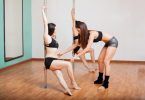Burning for that toned physique and killer confidence? Wondering if one hour of pole dance training per week is enough to get you there? We break down the factors to consider and help you design the perfect pole routine!
Pole dancing is all the rage, and for good reason! It’s a fantastic way to sculpt your body, boost your confidence, and have a blast while doing it. But with busy schedules, the question arises: is one hour of pole dance training per week enough to see results? The answer, like a sassy shimmy on the pole itself, is a nuanced “it depends!”
How Your Goals Shape Your Training
Before you lace up your pole dancing shoes (or ditch them entirely, some studios welcome bare feet!), it’s crucial to define your goals. Are you a total newbie, wide-eyed and eager to learn the ropes (literally)? Or are you a seasoned mover and shaker hoping to master those gravity-defying inversions?

Two young slim pole dance women upside down on white wall background
Pole Proficiency for Beginners
For newbies, one hour of pole dance training per week is a fantastic starting point. Your body is getting acquainted with a whole new realm of movement, and trust us, those muscles will be feeling it! One hour allows you to learn basic techniques, build foundational strength, and most importantly, have fun without pushing your body past its limits.
The Intermediate Advantage
As you progress, that one-hour session might start to feel a bit tame. That’s the beauty of pole dancing – there’s always a new challenge to conquer! Intermediate dancers who are comfortable with the basics can definitely benefit from upping their training to two, maybe even three sessions a week. This allows for more focused practice on specific moves, building endurance, and refining your flow and artistry.
Listen to Your Body: The Recovery Factor
Here’s the golden rule of pole dancing, or any fitness routine for that matter: listen to your body! One hour of training might leave you feeling energized, while two sessions might have you reaching for the ibuprofen. Rest and recovery are just as important as the training itself. Those micro-tears in your muscles need time to repair and rebuild, making you stronger for your next session.
Don’t Confuse Soreness with Injury
While some muscle soreness is normal after a challenging pole session, it’s important to differentiate between that and a full-blown injury. Sharp pains, persistent aches, or limited mobility are all red flags that you might be pushing yourself too hard. Don’t be afraid to take a break and allow your body to heal.

Beyond the Pole: Building a Well-Rounded Routine
Cross-Training is Your BFF
While pole dancing is phenomenal for building strength and flexibility, incorporating cross-training activities into your routine can take your progress to the next level. Consider activities like yoga, Pilates, or bodyweight exercises to enhance your core strength, flexibility, and overall fitness.
Fueling Your Fire: The Importance of Nutrition
Remember, you can’t out-train a bad diet! Nourishing your body with proper nutrition is essential for optimal performance and recovery. Focus on whole foods, lean protein, and complex carbohydrates to give your body the building blocks it needs to crush those pole routines.
Beyond the Studio: Maintaining the Pole Passion
You don’t have to be confined to the studio walls to keep the pole love alive. Here are some ways to extend your practice beyond your scheduled training:
- Embrace the Home Pole (if you have space): Investing in a home pole can be a game-changer. Even short practice sessions at home can help solidify your technique and allow you to experiment with moves at your own pace. Explore our range of high-quality, durable home poles designed to meet your needs.
- Pole Dance at Home (without a pole!): No home pole? No problem! There are plenty of bodyweight exercises you can do at home to build strength and flexibility that will translate beautifully to your pole dancing. Think planks, squats, lunges, and wall sits – all fantastic for building a strong foundation.
- Fuel Your Inspiration: Immerse yourself in the world of pole dancing! Watch online tutorials from professional polers, follow inspiring accounts on social media, or check out pole dance competitions (either in person or virtually). Surrounding yourself with this energy will keep you motivated and excited for your next session.
Frequently Asked Questions: Pole Training Edition
Q: I’m super busy, is one hour a week REALLY enough?
A: It depends on your goals! If you’re a beginner or have limited time, one hour a week is a great starting point. However, if you’re serious about progressing quickly, consider adding more sessions or incorporating cross-training.
Q: Will I see results with just one hour of training?
A: Absolutely! Even one hour a week can lead to increased strength, improved coordination, and a newfound confidence.
Q: Should I train every day?
A: Rest and recovery are crucial! Aim for 2-3 sessions per week with rest days in between to allow your body to rebuild and prevent injuries.
Wrapping Up: Your Personalized Pole Path
So, is one hour of pole dance training per week enough? The answer, as we’ve discovered, is a delightful “it depends!” Consider your goals, listen to your body, and don’t be afraid to experiment. Whether you choose one power-packed session or spread your training over a few shorter sessions, the most important thing is to have fun and celebrate your progress along the way.








